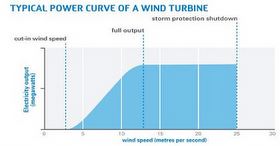The energy in the wind increases with wind speed. When the wind’s speed doubles, its energy content increases by eight. This means a wind turbine will generate more electricity as the wind speed increases. This relationship results in a variable supply of electricity from wind farms.
Typical power curve of a wind turbine
 Modern wind turbines can alter their generation very quickly, responding to gusts by turning their blades into or out of the wind. Modern wind turbines are designed to provide a smooth supply of electricity even though the source is variable and sometimes turbulent.
Modern wind turbines can alter their generation very quickly, responding to gusts by turning their blades into or out of the wind. Modern wind turbines are designed to provide a smooth supply of electricity even though the source is variable and sometimes turbulent.
If the wind speed increases suddenly a wind turbine’s control system will make automatic adjustments to prevent surges in electricity output. As turbines are arranged over a large area in a wind farm, often stretching several kilometres, a gust of wind won’t affect all of the turbines at the same time. For example, generation will ramp up during the time it takes a front to pass through a wind farm.
Wind speeds can be predicted days and hours ahead, and the output of a wind farm can be forecast in advance. With the right systems and tools in place, generation from other sources can be planned to accommodate fluctuations in wind generation. Hydro generation is particularly good for balancing wind generation as its energy can be stored (in the form of water in a hydro lake), and electricity output can be altered quickly.
It is highly unlikely that shifts in wind patterns would give rise to instantaneous power changes as large as those currently managed when a thermal generator goes off line because of a fault. In fact, wind turbines can significantly improve power system voltage stability, indicated by the fact that power system voltage is much better regulated when wind turbine generators (WTGs) are online than when they are not.
What about when the wind does not blow?
New Zealand is a windy country – a wind turbine here will produce electricity for about 90% of the time.
The geographic dispersion of wind farms results, overall, in a less variable supply of wind generated electricity. At the moment, a large portion of New Zealand’s wind generation is concentrated in the Lower North Island, and is subject to similar weather patterns. As wind farms are developed throughout New Zealand we will see less variability in total wind generation.
On a quarterly and annual basis wind generation is much more consistent than hydro. As energy sources are managed on an annual time frame (we talk about dry years, not dry days or minutes) it is this longer term consistency that is important.
Wind energy has a natural synergy with New Zealand’s existing hydro resources. If we use wind’s energy when it is available, then we can save the water stored in our hydro lakes. This stored water gives us more choices for generating electricity. We can:
- save the water to use another day – perhaps when low levels of wind generation or water inflows are expected
- use the water to meet fluctuations or daily peaks in demand
- use hydro instead of thermal generation to meet normal levels of demand.
